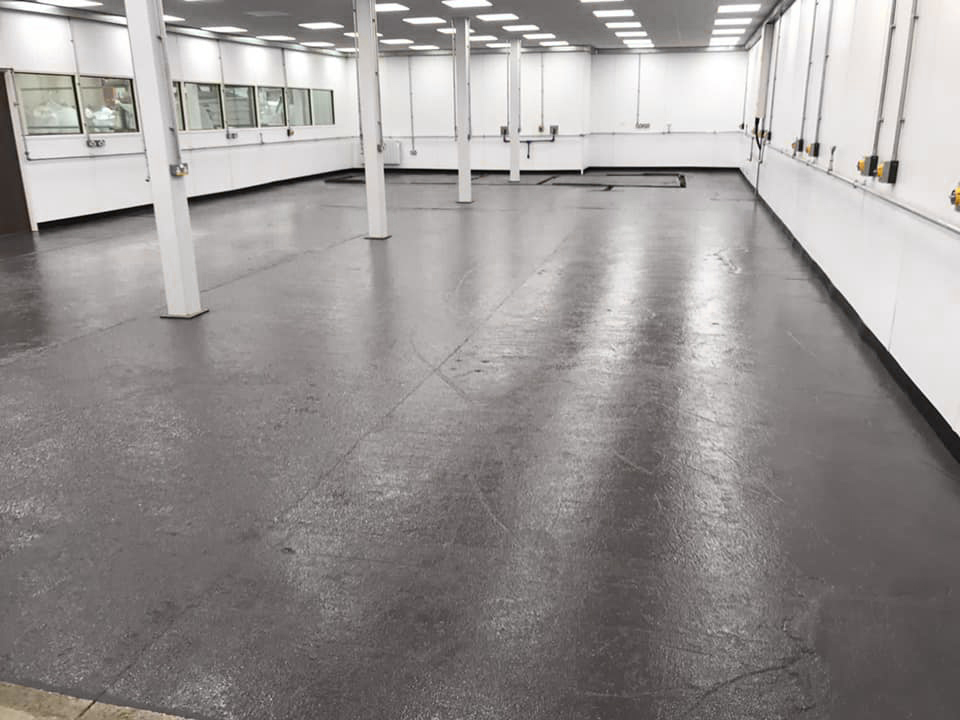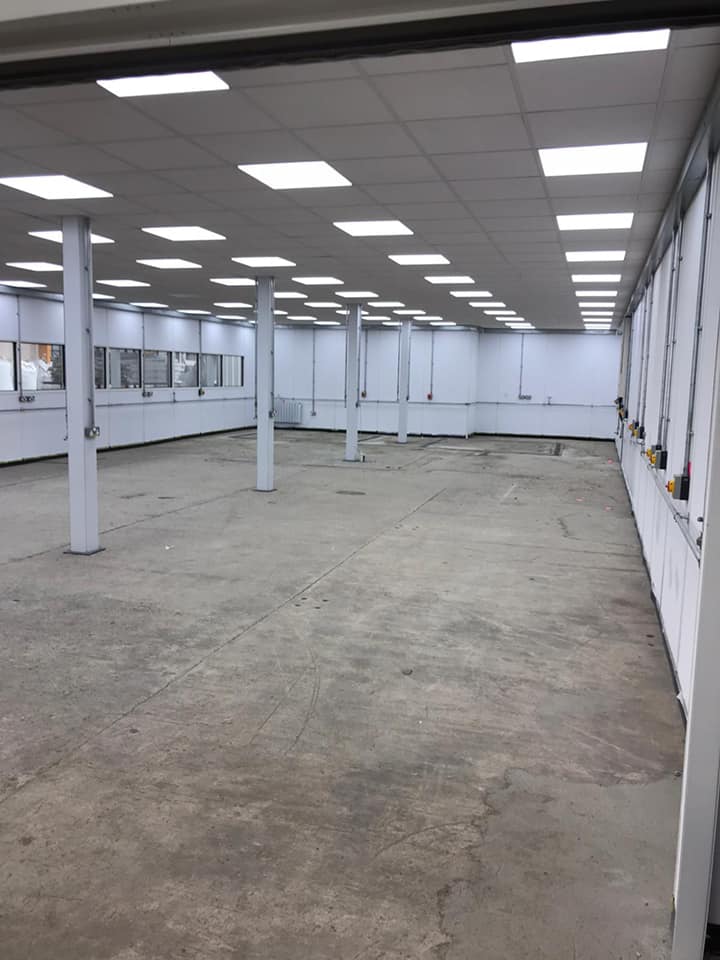
Winter, I’m sure everyone is trying not to think too much about it yet, and instead trying to cling to the end of Summer. But if you have an industrial property, garage or workshop that needs a fresh coat of paint, winter is something to look forward to! How do you use concrete floor paint?
Summer is the best time for all your outdoor painting projects, but as the cold weather draws in, it’s time to move inside and give your interiors some well-deserved attention. No one likes to be painting outside in the cold, and if an unprecedented rain cloud appears it can delete hours of work in minutes.
This guide will also give you advice on outdoor painting and the steps can be followed the same way, just be sure to keep an eye on the weather forecast!
Painting Concrete Floors
Large-scale painting isn’t an easy job, so getting it right the first time is important to save both time and money. Painting concrete isn’t the same as painting regular surfaces, so you should always be sure you’re doing it correctly. Many industrial and commercial properties have interior concrete floors.
These include:
- Factories
- Garages
- Barns
- Warehouses
- Gyms & Sports Centres
- Film Studios
- Classrooms
- And many more!
The amount of concrete floor paint you’ll need will vary but is easy to calculate if you measure the floor. 1 litre of paint will cover approximately 6-8m² so 1 of our 20L drums of concrete floor paint
should cover about 120-160m². Once you have your estimate, multiply it by two, as you’ll need at least two coats for the ideal finish.
No matter how clean you keep them, eventually every concrete floor will start to look a little tired and worn out. A fresh coat of paint is an inexpensive option to freshen up your floor.
Floors and ceilings are often an afterthought when painting, a job saved for ‘next time’ when walls are redone. This leaves them needing more care when the time comes.
How to Paint a Concrete Floor
Painting an interior concrete floor can be split into 4 simple steps. To save yourself some time, we recommend reading each step thoroughly so you can prepare everything you need well in advance. It can be a lengthy process so setting enough time aside with room for delays will keep everything running smoothly.
Step 1 – How to Clean a Concrete Floor
Rejuvenating a concrete floor takes more than just a few cans of concrete floor paint. The first step is to clean the floor thoroughly. Skipping this step or doing the bare minimum could ruin the floor or make it look worse than if it hadn’t been painted at all. Using a pressure washer will make the job easier, however some elbow grease is always needed for any tricky parts.
If you’re repainting a garage or painting a factory floor, you’ll likely have some stubborn oil or grease stains that soap and water won’t remove completely. When this is the case, you should use a degreaser or some detergent and then scrub thoroughly before the floor dries. Some pressure washers incorporate a degreaser already if it is a high end model.

Step 2 – How to Strip Old Paint
If your floor has been painted before, you should use a chemical stripper to remove the previous layers of paint and sealer. This gives you a blank canvas to work with and gets the floor ready to seal and prime.
If you don’t want to use a chemical stripper, you can do it the old fashioned way! You have two choices: a wire brush or paint scraper
is the cheaper option but needs a lot more elbow grease. Or you can use a power washer to blast the paint away. If you used a pressure washer for the cleaning, you’ll have done a chunk of the work already!
Step 3 – How to Seal Interior Concrete
Next you need to seal the interior concrete. An essential step, as it prevents the floor becoming dusty over time and also stops the coloured concrete floor paint soaking into new concrete floors unevenly.
Sealing the concrete floor first gives a more uniform absorption across the surface and gives a much more professional finish. The method for using sealer varies from product to product and depends on the floor you are sealing.
Here are the floor sealers we recommend:
A polyurethane sealer is best for a normal concrete floor with a generic uneven surface where it has been previously unpainted or is new but has cured thoroughly.
A quick dry alkyd floor sealer is best for a very smooth surface (a buffer or similar may have been used) or where a polyurethane sealer wouldn’t adhere well.
It is recommended with either sealer to use 2 thin coats with time to cure between coats. You may be keen to get to the painting, but patience is a key factor, and you will get better results in the end.
Top Tip: If the floor has already been painted before and just needs a freshen up… you can skip this step. Make sure the product you choose can be applied onto the old paint and the floor is prepped and primed correctly as per the last step.
Step 4 – How to Paint a Concrete Floor
If you’re painting a concrete floor, you need paint designed for the job. Polyurethane concrete floor paints are perfect for most concrete surfaces. They are damage resistant and easy to apply. They are a durable choice and provide long-lasting protection for your floors.

Here are the paints we recommend:
Our Polyurethane floor paints can be used in sprayers* for a professional finish, (1 part white spirit to 5 parts paint is the ideal ratio for thinning with polyurethane paints).
Quick dry alkyd floor paints can be used in sprayers* for a smooth finish (1 part water to 5 parts paint is the ideal ratio for thinning water based products for spraying).
Using a paint brush or roller set may take a little longer by hand but still provide a superb finish and without the need to hire or buy extra equipment.
No matter which option you choose, you’ll need at least two layers of concrete floor paint. Take your time to get an even coverage and give each layer enough time to fully cure before continuing.
*check the airless sprayer you choose is suitable for the job beforehand.
Ready to Get Started?
We hope this guide was helpful and your concrete floor will soon be looking great! Check back again soon for even more DIY, renovation, and refurbishment insights from our team. In the meantime, please check out our products or get in touch to find out more.
See you next time!
FAQ's
Can I use masonry paint on concrete floor?
Masonry paint does work on concrete floors. However, specialist concrete paint will last longer, as it offers more protection for horizontal surfaces. If paired with a quality primer and sealant, both masonry paint and concrete paints look great on concrete floors.
Do I need to prime concrete before painting?
You need to prime your concrete floors before you paint them. Primer creates a better surface for paint to cling to, which in turn makes the colour bolder and adds extra protection.
Do I need to seal concrete floor before painting?
You should seal and prime your concrete floors before you paint them. If you skip this step, your paint finish won’t look good, and your floor won’t be protected.
Do I need to wash concrete floor before painting?
The first step in preparing concrete for paint is to thoroughly clean the area. Whether you’re preparing old or new concrete surfaces for painting, it’s important to remove any surface debris that can easily be swept up or vacuumed.
How long does concrete floor paint take to dry?
If you’re using any kind of oil-based paint, you can normally expect it to be dry in 6-8 hours. Although it may be dry to the touch, you should leave it up to 24 hours before applying a second coat.
How to remove concrete floor paint?
- Step 1: Give the concrete surface a deep cleaning and allow it to dry.
- Step 2: Apply paint stripper.
- Step 3: Give the paint stripper some time to set.
- Step 4: Scrub the surface.
- Step 5: Follow up the scrubbing with a power wash.
- Step 6: Repeat as necessary until all the paint is removed.
- Step 7: Clean the area to get rid of all paint stripper.
Is concrete floor paint durable?
They are more durable than standard interior or exterior wall paints and can withstand a lot more abuse. Generally, you have two options to choose from: a water-based acrylic latex or an epoxy concrete coating. An acrylic latex concrete paint is easier to work with and is applied similarly to latex-based house paint.
Is painting concrete floor a good idea?
Painting and sealing your concrete floors can increase their durability, extend their lifespan, and transform your spaces.
Is painting concrete floor a good idea?
Bare concrete will wear out quickly, and is more prone to damage, By painting concrete floors you don’t just make them look better, you protect them for years too. Our polyurethane floor paint even repels dust and stains.
What is the best floor paint for concrete?
Our polyurethane floor paint is the best for a wide range of concrete surfaces, including factories, garages, gyms, studios, and more! It offers excellent protection from scuffs, scratches and is naturally stain resistant as well.
What types of Concrete Paint do Paintmaster Supply?
Latex (Paintmaster Quick Dry Acrylic Floor paint)
- 1 pack Polyurethane Based paint (Paintmaster polyurethane floor Paint)
- 2 pack epoxy paint
